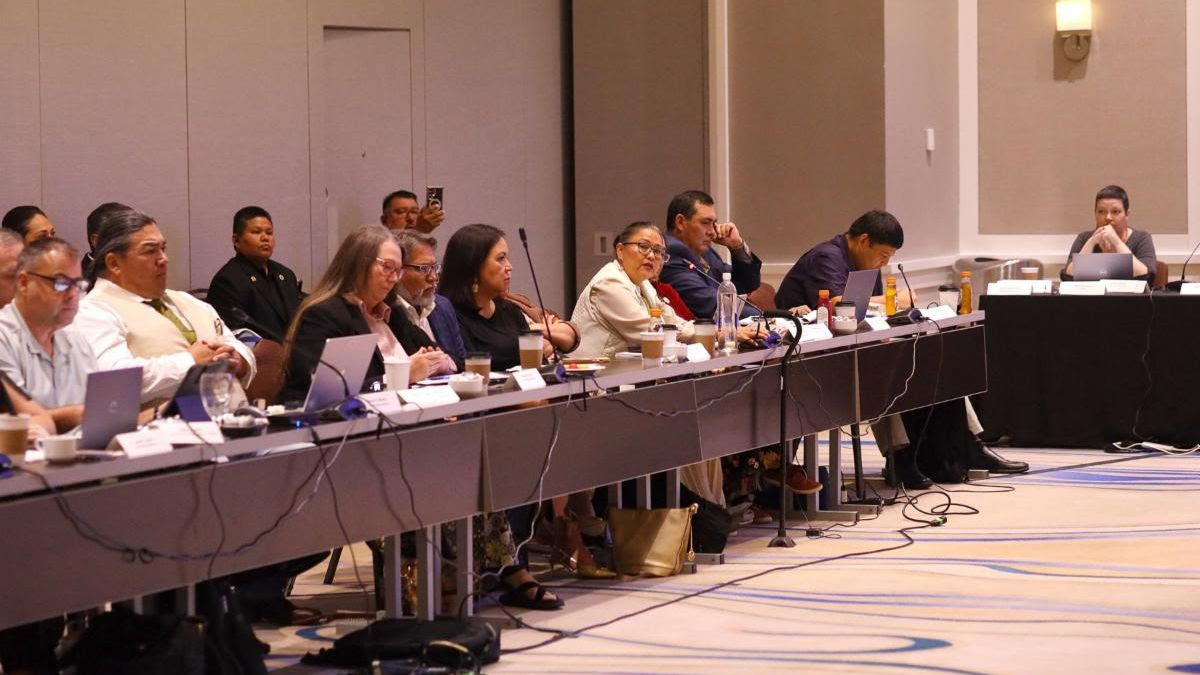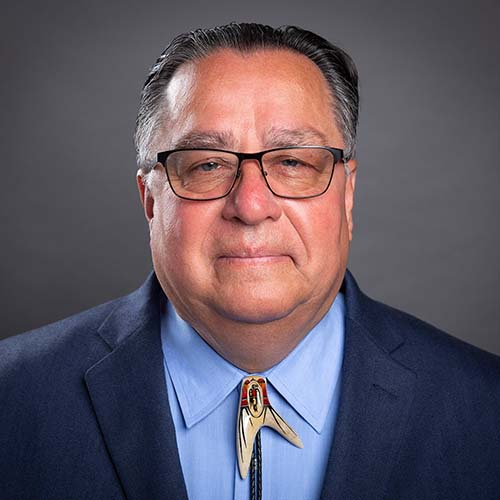
- Details
- By Native News Online Staff
At the August 4–7 quarterly meeting of the Tribal Interior Budget Council (TIBC) in Tulsa, Oklahoma, members of the 25th Navajo Nation Council joined other tribal leaders in voicing strong opposition to proposed flat funding and unfunded priorities in Indian Affairs budgets—marking the third consecutive year of such pushback.
On August 5, Assistant Secretary for Indian Affairs Scott Davis and Bureau of Indian Affairs (BIA) Director Bryan Mercier informed TIBC that the 2026 House and Senate budget marks would fund Indian Affairs programs at or above 2024 and 2025 levels. However, they noted a significant gap in the presidential request: President Donald Trump’s FY2026 proposal calls for $2.7 billion—$1.2 billion less than the $3.9 billion provided under the FY2025 Continuing Resolution.
Council Delegate Eugenia Charles-Newton, co-chair of TIBC’s Public Safety & Justice Subcommittee, spoke candidly about the chronic underfunding of Indian Country. She emphasized the federal government’s trust responsibility to fully support Indian Affairs programs.
“Our budget has never been enough. Your job is to fight for tribes. Our relatives are beaten down by life and called resilient as they struggle to maintain their livelihood,” Charles-Newton said. “What I want to hear from our federal partners is not that you understand our struggles, but what you are going to do about them.”
Charles-Newton also highlighted a proposed $84 million cut to tribal public safety programs in the president’s budget. She stressed that members of the Law and Order Committee have been consistently advocating for increased and mandatory funding to improve tribal law enforcement and justice services.
Current staffing levels on the Navajo Nation remain well below national standards. According to the Tribal Law and Order Act, there should be 2.8 officers per 1,000 residents. On the Navajo Nation, there is just one officer per 917 members.“We advocate for mandatory funding specifically for the Office of Justice Services and the 197 tribes that receive law enforcement and criminal investigation funds because of the manpower shortages we face,” said Charles-Newton.
The Council also received updates on education funding. Bureau of Indian Education (BIE) Director Tony Dearman and Deputy Director Sharon Pinto reported that funding for the Operation of Indian Education Programs (OIEP) has remained flat at approximately $1.1 billion since FY2023.
Dearman noted that the BIE serves over 400,000 American Indian and Alaska Native students, from early childhood through higher education. Despite this reach, per-pupil funding stands at $7,500—significantly below the national average of $25,000.
“As tribal leaders, it’s our responsibility to make sure our numbers increase,” Dearman said. “What we’re seeing in terms of funding is inequity.”
Dearman also shared staffing challenges. Since January 20, 2025, the BIE has lost 150 employees under the Deferred Resignation Program and is currently under a hiring freeze, with additional cuts anticipated.
While President Trump’s FY2026 request maintains flat funding, the House Interior Bill includes a $104 million increase for OIEP and a $61 million increase for education construction, compared to FY2025 levels.
In transportation, BIA Division of Transportation Chief LeRoy Gishi stated that funding for the Tribal Transportation Program (TTP) has remained flat since FY2024. However, BIA received an additional $150 million in FY2025 for the program.
Council Delegate Otto Tso, co-chair of the TIBC Transportation Subcommittee, raised concerns about the TTP funding formula and its disproportionate impact on tribes.
“We need to educate Congress on the realities of tribal transportation needs so they understand that failing to fund transportation at the maximum threshold means underfunding critical infrastructure that supports all BIA-funded programs,” Tso said. “We want the federal government to live up to their federal obligation in funding Indian Country, to meet their needs.”
“These formulas created by Congress are not helping us,” Tso added.
Tribal leaders also expressed frustration over the delayed release of the FY2026 Green Book, a vital resource for planning tribal budgets.
In closing, Assistant Secretary Scott Davis acknowledged the concerns raised and reaffirmed the Department’s commitment to tribal nations.
“Thank you for your comments and strong voices—they are important reminders of our role as your trustee,” Davis said. “I can assure you our staff is working hard every day for Indian Country. We know we’re not in a good place with the Interior right now but please know we are fighting for you.”
Council Delegates Curtis Yanito, Nathan Notah, and Germaine Simonson were also in attendance at the TIBC meeting.
More Stories Like This
Native News Weekly (August 25, 2024): D.C. BriefsUS Presidents in Their Own Words Concerning American Indians
Indigenous Actor Elaine Miles Reports Detention by Alleged ICE Agents
Happy Thanksgiving from Native News Online
Coming Up on Native Bidaské: Behind the Animation: Joey Clift Talks “Pow” and Native Storytelling
Help us tell the stories that could save Native languages and food traditions
At a critical moment for Indian Country, Native News Online is embarking on our most ambitious reporting project yet: "Cultivating Culture," a three-year investigation into two forces shaping Native community survival—food sovereignty and language revitalization.
The devastating impact of COVID-19 accelerated the loss of Native elders and with them, irreplaceable cultural knowledge. Yet across tribal communities, innovative leaders are fighting back, reclaiming traditional food systems and breathing new life into Native languages. These aren't just cultural preservation efforts—they're powerful pathways to community health, healing, and resilience.
Our dedicated reporting team will spend three years documenting these stories through on-the-ground reporting in 18 tribal communities, producing over 200 in-depth stories, 18 podcast episodes, and multimedia content that amplifies Indigenous voices. We'll show policymakers, funders, and allies how cultural restoration directly impacts physical and mental wellness while celebrating successful models of sovereignty and self-determination.
This isn't corporate media parachuting into Indian Country for a quick story. This is sustained, relationship-based journalism by Native reporters who understand these communities. It's "Warrior Journalism"—fearless reporting that serves the 5.5 million readers who depend on us for news that mainstream media often ignores.
We need your help right now. While we've secured partial funding, we're still $450,000 short of our three-year budget. Our immediate goal is $25,000 this month to keep this critical work moving forward—funding reporter salaries, travel to remote communities, photography, and the deep reporting these stories deserve.
Every dollar directly supports Indigenous journalists telling Indigenous stories. Whether it's $5 or $50, your contribution ensures these vital narratives of resilience, innovation, and hope don't disappear into silence.
 The stakes couldn't be higher. Native languages are being lost at an alarming rate. Food insecurity plagues many tribal communities. But solutions are emerging, and these stories need to be told.
The stakes couldn't be higher. Native languages are being lost at an alarming rate. Food insecurity plagues many tribal communities. But solutions are emerging, and these stories need to be told.
Support independent Native journalism. Fund the stories that matter.
Levi Rickert (Potawatomi), Editor & Publisher

